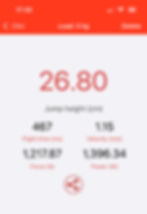Elevate Patient Outcomes: Harnessing Jump Analysis for Better Rehabilitation Outcomes
- Uzo Ehiogu
- May 18
- 4 min read

In the ever-evolving world of rehabilitation and sports therapy, keeping up with innovative tools is key to enhancing patient outcomes. Enter the My Jump app, a game-changer for vertical jump testing that provides precise performance metrics right at your fingertips. Designed to cater to diverse patient populations, this app offers an accessible way to conduct comprehensive jump assessments, making it easier than ever to tailor rehabilitation strategies.
Whether you're an early career physiotherapist or a seasoned sports therapist, understanding how to use jump analysis can elevate your practice and boost your patients' recovery journeys. This cutting-edge tool can transform your approach to rehabilitation and your support professional growth [https://pmc.ncbi.nlm.nih.gov/articles/PMC10547091/].
Understanding Vertical Jump Testing
Vertical jump testing is a cornerstone in rehabilitation and sports performance assessment. So, let's explore its importance and the tools that are revolutionizing sports rehabilitation and performance.
Importance in Rehabilitation
Power testing should be an important part of many rehabilitation programmes. However the kit required to measure this physical capacity is expensive and beyond the means of many therapists. But...Vertical jump testing using a mobile phone app offers valuable insights into a patient's progress and physical capabilities.
By measuring vertical jump performance, therapists can assess lower body power, velocity, force and overall functional ability. This information is vital for creating targeted rehabilitation programmes and tracking improvements over time.
A study published in the British Journal of Sports Medicine highlights the significance of vertical jump testing in predicting athletic performance and injury risk. However, its not just for athletes, though – this assessment can benefit patients recovering from various lower limb injuries and surgeries.
Regular vertical jump assessments allow therapists to objectively measure progress, motivate patients, and make data-informed decisions about treatment plans. This approach ensures that rehabilitation is both effective and tailored to each individual's needs.

Tools and Technology: My Jump App
The My Jump app has revolutionized vertical jump testing, making it accessible and precise for therapists and patients alike.
This innovative app uses smartphone technology to capture and analyze jump performance with remarkable accuracy. By simply recording a video of the jump (see video below), the app calculates key metrics such as jump height, flight time, and power output.
The My Jump app's user-friendly interface allows for quick and easy data collection, making it ideal in a busy clinical setting.
Moreover, the app stores and tracks data over time and provides you with a comprehensive overview of your patient's progress. This feature is a game changes for long-term rehabilitation planning and goal setting.
Implementing Jump Analysis
Let's examine how to effectively implement it into your practice.
Key Performance Metrics
When conducting jump analysis, several key performance metrics provide valuable insights into a patient's progress and capabilities.
Jump Height is the primary metric, indicating the maximum vertical displacement achieved during the jump. This measure directly reflects lower body power and is crucial for tracking improvements over time.
Flight Time and Ground Contact Time are also essential metrics. Flight time correlates with jump height and is reflective of your take off time velocity, which is related to how much force you put into the ground and the strength of your lower limb extensors.
Ground contact time can indicate the efficiency of the jump technique and the reactive strength of the lower limbs.
Power Output is calculated using the patient's body weight and jump height. This metric is particularly useful for assessing overall lower body strength and explosive power.
Recent research has shown that analyzing these metrics can provide early indicators of injury risk and readiness to return to sport.
Tailoring Rehabilitation Strategies
Effective implementation of jump analysis allows you to tailor rehabilitation to each patient's physical capabilities and end outcome goals.
Establish a baseline: Conduct initial jump assessments to determine the patient's starting point.
Set realistic goals: Use the baseline data to set achievable, measurable objectives for improvement.
Design targeted interventions: Create rehabilitation programs that address specific areas of weakness identified in the jump analysis.
Regular reassessment is key to tracking progress and adjusting the rehabilitation plan as needed. This data-informed approach ensures that your therapy remains effective and motivating for the patient.
A study in Nature suggests that personalized rehabilitation strategies based on jump analysis can lead to faster recovery times and reduced risk of re-injury.

Advancing Patient Outcomes
By harnessing the power of jump analysis, we can significantly improve patient outcomes across various populations.
Enhancing Patient Populations' Performance
Jump analysis can benefit a wide range of patient populations, from professional and recreational athletes recovering from injuries to manual workers recovering after surgery.
For athletes, jump analysis provides crucial data on power output and symmetry between limbs. This information is vital for safe return-to-play decisions and ongoing injury prevention strategies.
Research published in PMC demonstrates that regular jump assessments can help identify early signs of muscle weakness or imbalances in various sporting populations, allowing for proactive intervention.
Best Practices in Jump Assessment
To ensure accurate and meaningful results, it's essential to follow best practices when conducting jump assessments.
Standardize the testing protocol: Use consistent instructions, warm-up procedures, and testing environments for all assessments.
Ensure proper technique: Educate patients on correct jumping form to avoid skewing results due to poor technique.
Consider fatigue factors: Schedule assessments when patients are well-rested for the most accurate representation of their capabilities.
It's crucial to interpret results in context, considering factors such as the patient's age, injury history, and overall health status.
Regular calibration of measurement tools, whether using the My Jump app or other devices, is essential for maintaining accuracy over time.
By adhering to these best practices, therapists can ensure that jump assessments provide valuable, actionable data to guide rehabilitation strategies and improve patient outcomes.
Thanks for reading !
